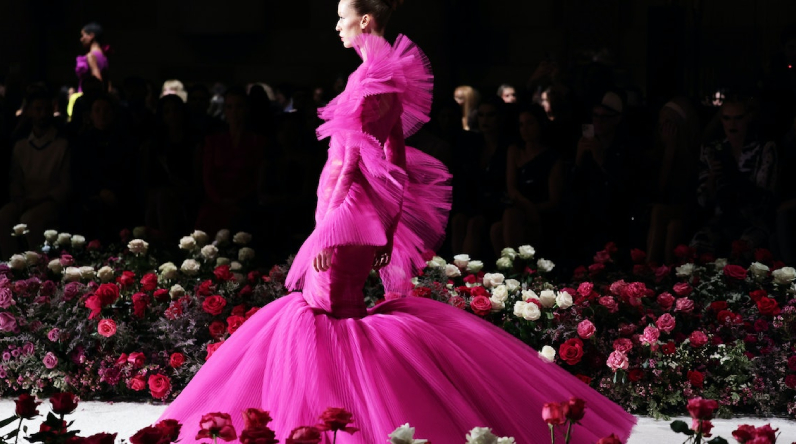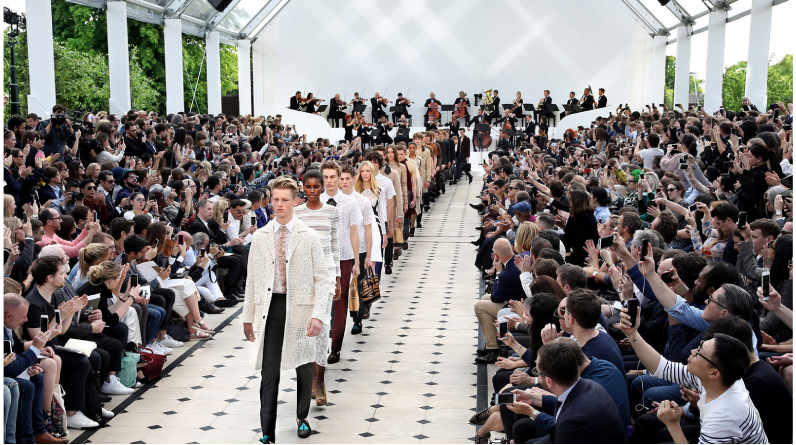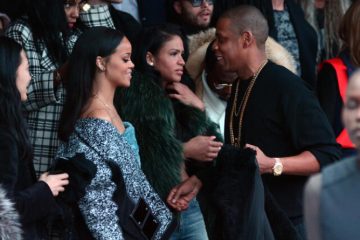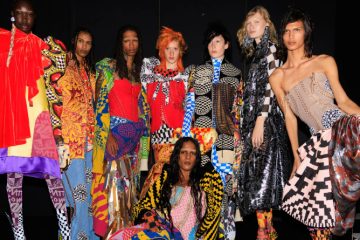New York Fashion Week is a hive of activity for smaller labels

On Friday night, I had the thought, “There’s something a bit different about New York Fashion Week this season,” when a model in dog ears, muzzle-like facial prosthetics, and a T-shirt reading “woof” crawled down the catwalk on all fours.
Granted, this occurred at Collina Strada, a renegade label beloved by millennials for its diverse staff and environmental consciousness. The animal theme this season brought attention to the brand’s much-copied $200 shrunken mesh shirts and $400 combat trousers while sending a nonpreachy message about veganism (there were real dogs, cat’s whiskers, prosthetic beaks, rooster headpieces, and swishing tails).
This wasn’t even the most bizarre thing to happen this week. At Rodarte, there were fairies with enormous wings; at Thom Browne, aliens with long, spiralling fingernails and toenails; and at Area, there were dresses made from enormous bananas. The crowds were not anticipating any of these outcomes. Because conventional wisdom has held for a long time that New York Fashion Week is more about making money than it is about pushing creative boundaries; that it is where we find the headquarters of global brands like Ralph Lauren, Calvin Klein, and Tommy Hilfiger, but not where we see the zeitgeist shift as seen through the eyes of innovative designers.
This idea has been threatened for quite some time. Recently, many of the most prominent names in American fashion have been absent from the schedule for unknown reasons; for example, this season, Calvin Klein, Ralph Lauren, Tommy Hilfiger, Marc Jacobs, and Tom Ford did not show, leaving only Michael Kors and Coach as the two largest remaining brands.
The remaining shows were by lesser-known designers that not even the fashion industry had heard of. Some British media outlets lamented the lack of stardust, but the Americans I spoke with had a more positive take, saying that the openings created were perfect for the introduction of much-needed raw talent.
Gary Wassner, CEO of Hilldun, which provides billing and financing services to hundreds of American and international fashion brands, said, “Everyone feels optimistic.” As one reviewer put it, “the schedule feels a lot more creative and innovative — full of brands that are not soldiers in a row, that are focusing on newness and freedom and gender-neutral product, and are doing that authentically.”
Thom Browne, known for dressing celebrities like Cardi B and Kristen Stewart in his signature grey shorts suits and four-stripe socks, was undoubtedly the most well-known designer on the roster. Browne has also assumed leadership of the CFDA (the Council of Fashion Designers of America). Before the shows, he emailed the designers and told them to “let it rip” with their designs. Let’s all get a little bit scared, he wrote, and share some stories we can be proud of. This season, he went a little crazy on his own.

Models explored what appeared to be a new planet at his show at The Shed theatre in Hudson Yards, which drew inspiration from the novel The Little Prince. Models of both sexes wore long, form-fitting dresses, Saturn Ring headpieces, and curly white manicures and pedicures to portray extraterrestrials. Whoopi Goldberg and Queen Latifah, among other celebrities, sat front row and got a great look at the mind-blowing garments, which included office shirts and jackets spliced together to form conceptual silhouettes reminiscent of Comme des Garçons’s.
Underneath their experimental outer layers, the models wore lean woollen turtleneck dresses, so there were some wearable pieces (turtleneck dresses were something of a trend, seen at Coach, Gabriela Hearst, Carolina Herrera and more). Backstage, Browne told reporters that the show “is never about selling the clothes” for him. They focus on the concepts that drive retail sales of clothing displays.
Head of State, a label founded by Taofeek Abijako in his bedroom when he was 17 (he’s now 24) and now touring the world, also put on a memorable show. The story of his father’s arduous journey from Lagos, Nigeria, to Spain, which he began but ultimately abandoned before winning a US visa lottery inspired his moving collection. Models walked the runway in gauzy bodices with corset boning, asymmetric elasticized tops, and roomy trousers with contrast cut-outs as show notes compared the journey to the current refugee crisis. A model’s dress dissolved as she twirled inside a water-filled Perspex box on stage, revealing a white one-piece swimsuit underneath.
Also Read :Will AI Completely Revolutionize Digital Advertising
This was just one of many unique stories told this season, and it was a far cry from the Waspy narratives that had previously dominated New York Fashion Week. Luar, the final show of the week, was based on designer Raul Lopez’s obsession with calle pero elegante (Spanish for “street elegance”) during his formative years in the Dominican-American community of Williamsburg, Brooklyn.
The designer Sergio Hudson became famous overnight after dressing Michelle Obama in a stunning burgundy gown for Joe Biden’s inauguration. Backstage, he said, “For a long time it was, like, New York is boring.” This was before his high-energy show of neon suiting inspired by the winning combination of Fran Drescher from The Nanny, Hilary Banks from The Fresh Prince of Bel-Air, and Barbie. Now that we’ve rebuilt and gotten people to come back and see that our perspective is valid, too, they see it.
The question of whether or not small businesses can compete with the marketing muscle of European giants like LVMH and Kering remains open in the face of the current economic climate.
Last year’s CFDA American Womenswear Designer of the Year, Catherine Holstein, also the creative director of Khaite, has just opened her first store and surpassed the $100 million mark in sales. She says that life as an independent person is “very gruelling. Financial discussions take up the bulk of my time. I’ve had a lot of prior failures, but it takes a lot of failures to succeed. Now there’s only one guy left.
Even though her show took place on the poured-concrete floors of her new SoHo boutique and featured a fantasy wardrobe of ultra-luxurious shearling coats, fluffy mules, and leather boots, there was no sign of nervousness.
Bain & Company, a management consulting firm, has a positive outlook. Despite inflation and the war in Ukraine, it predicts the $353 billion personal luxury goods market will grow by as much as 8 percent this year. Brands need to do everything they can to win over Generation Z, whose oldest members are in their mid-twenties now and who are expected to account for 40 percent of luxury buyers by the year 2035.
Bain’s global head of fashion and luxury Claudia D’Arpizio says consumers are attracted to “purpose-driven” brands that incorporate “cultural avant-garde” and “insurgent excellence” into their operations. Indeed, New York’s independent designers have a lot of those qualities, much more than the big labels that are often (and rightly) accused of greenwashing and performative diversity. Maybe the city has a better chance of succeeding than its critics believe.
Leave a reply
You must be logged in to post a comment.








